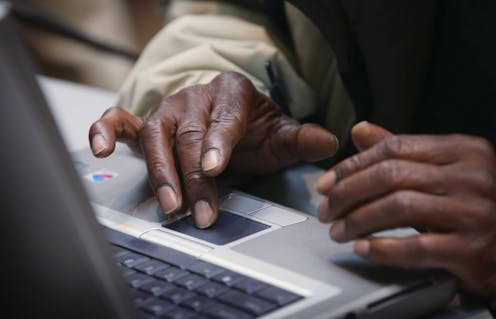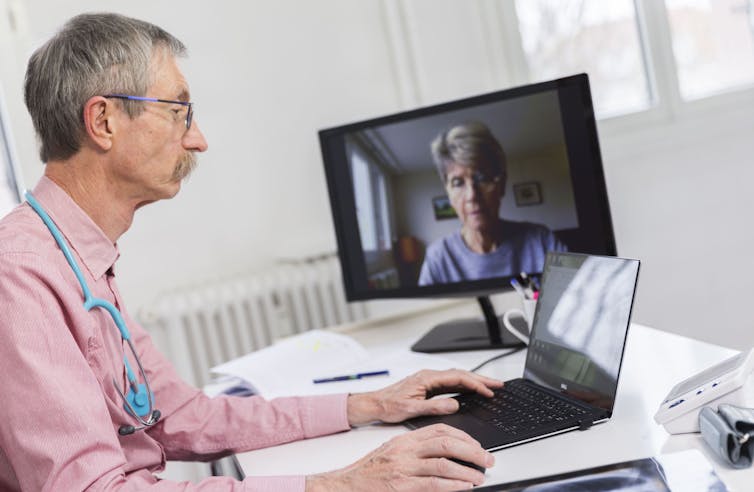No internet, no vaccine: How lack of internet access has limited vaccine availability for racial and
Early numbers show that people from racial and ethnic minorities have lower vaccination rates. Lack of internet access could be a reason.

Racial and ethnic minority communities that lack internet access have been left behind in the race to get a COVID-19 vaccine. The average monthly cost of internet access, about US$70, can be out of reach for those who can barely afford groceries.
Reporters and scholars have written about the effects of lack of internet access in rural areas in the U.S. and developing countries, but they have paid less attention to the harm of lack of internet access in racial and ethnic minority communities in major cities.
We are researchers who study health disparities. We are concerned that even when vaccinations are offered in these communities, those at greatest risk for COVID-19 may be unable to obtain appointments without the help of family or friends. This includes racial and ethnic minority communities and older adults, the age group that is currently being vaccinated.
Our research suggests that lack of internet access may be an important reason. And for the almost 13.8 million older adults in the U.S. who live alone, asking for help may not be an option.
The computer as COVID-19 connector
During the pandemic, the internet has been an indispensable health tool to millions.
Telehealth services have provided a safe way for patients to make appointments for COVID-19 testing and other types of medical care. In fact, there was a 154% increase in telehealth visits during the last seven days of March 2020 compared to the same period in 2019. This was most likely due to public health mandates that required a shift away from in-person care.
In addition, patients receive communications from their providers through email and other messaging systems that offer access to health care, health information and test results. And, departments of public health and the Centers for Disease Control and Prevention have relied on their websites, online events and social media to educate the population about COVID-19. Access to the internet is essential during a pandemic.
This has been particularly true as the vaccine has been rolled out. Signing up for the vaccine has predominantly occurred online. This means that far fewer older adults from underresourced racial and ethnic minority communities have been able to make appointments.
In 2018, more than one in four Medicare beneficiaries had no digital access at home. Those without digital access were more likely to be 85 years or older, members of racial or ethnic minority communities and from low-income households.

How internet access can determine health
Over the years, medical and public health experts have identified social factors – structural racism, a person’s neighborhood, access to fresh food, exposure to toxins, income and education – that play a major role in health. These factors are often called the social determinants of health. Experts consider structural racism, or racism ingrained in social, business, educational and health policy and practice, to be one of the most damaging determinants. These factors in turn ultimately lead to more disease and death, as they have with COVID-19.
Early data on the case numbers and deaths from COVID-19 showed that structural racism likely increased exposure to the coronavirus among racial and ethnic minority communities. And, racial gaps also impeded access to testing and affected quality of care.
The pandemic has also illuminated the risk of infection to our aging population. However, research has placed less emphasis on how aging affects some populations more than others, such as the effects of structural racism and income.
Now, it appears that internet access is emerging as a new and troublesome determinant of health. This appears to be particularly true for underresourced racial and ethnic minority communities and aging populations.
Although people can make appointments for a COVID-19 vaccine by telephone, call centers are frequently overwhelmed. Hold times can be extremely long. Access to the internet, having an internet-enabled device and understanding how to use both have been necessary to sign up for the vaccine. Many advocacy groups and public health experts have begun to see internet access as a fundamental civil rights issue.
During the fall of 2020, we looked at this issue in more depth with Black and Latino individuals who are HIV positive and at risk for a cardiovascular event. In our research, we found that 17 out of 30 patients had no internet, no computer or lacked knowledge of how to use the internet or a computer. They, like many people with health issues or from underresourced racial and ethnic minority communities, are affected by numerous social determinants that amplify the negative health consequences they experience.
While online health services could be used to increase access and retention in care among vulnerable groups, not having access widens existing disparities.
Solutions exist, but they must be implemented
To address the internet gap, we believe that policymakers must identify lack of internet access as a barrier and protect against its effects. This could include reserving vaccines in underresourced racial and ethnic minority communities for local residents and designating senior hours for those 65 and older.
Policymakers could also mandate timely reporting of demographic information, even within medical settings, to monitor equity. Public health administrators could also partner with organizations that work with vulnerable populations, such as Meals on Wheels, to deliver food and vaccines to individual homes.
[Deep knowledge, daily. Sign up for The Conversation’s newsletter.]
Departments of public health also could work with organizations and trusted community leaders to produce culturally consistent multimedia information on vaccinations and other health topics. They could also arrange for billboards, freeway signs and posters at local restaurants.
In addition, health care professionals and organizations can help by teaching patients about government subsidies and internet programs for low-income individuals from internet service providers. They can also provide training on how to use the internet, which would be at least a good beginning for these vulnerable groups.
Tamra Burns Loeb receives funding from the UCLA David Geffen School of Medicine COVID-19 Research Award Program and the National Heart, Lung, and Blood Institute.
Arleen F. Brown receives funding from the National Institutes of Health.
Paris "AJ" Adkins-Jackson does not work for, consult, own shares in or receive funding from any company or organisation that would benefit from this article, and has disclosed no relevant affiliations beyond their academic appointment.
Read These Next
From truce in the trenches to cocktails at the consulate: How Christmas diplomacy seeks to exploit s
World leaders like to talk up peace at Christmastime. But alongside the tales of seasonal breaks in…
As DOJ begins to release Epstein files, his many victims deserve more attention than the powerful me
Powerful men connected to Jeffrey Epstein are named, dissected and speculated about. The survivors,…
The world risks forgetting one of humanity’s greatest triumphs as polio nears global eradication − 7
Polio may finally be defeated in the next 5 years. Will the world recognize what an extraordinary achievement…






